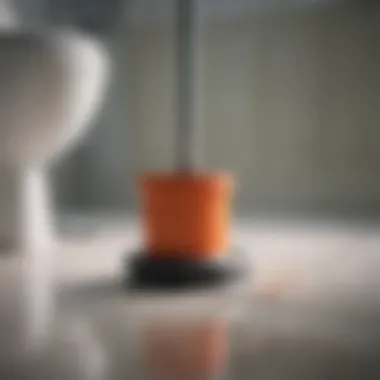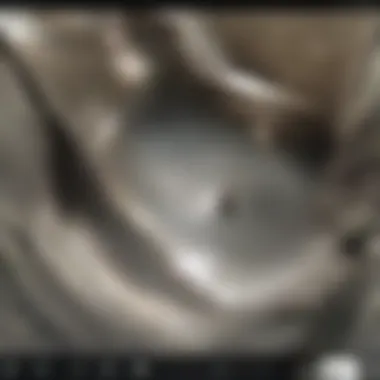Effective Techniques for Unclogging Toilets and Drains


Intro
Clogged toilets and shower drains are common issues encountered by homeowners. These problems can lead to unpleasant experiences and potential damage if not addressed promptly. Understanding the causes and adopting effective techniques for unclogging these fixtures is essential for maintaining a functional home environment.
This guide aims to provide homeowners and design enthusiasts with practical solutions for dealing with clogs. We will discuss common causes, various DIY methods, necessary tools, and when to call a professional plumber. With informative insights and actionable advice, you will be better prepared to tackle drainage issues as they arise.
Understanding Toilet and Shower Drain Clogs
Understanding toilet and shower drain clogs is vital for homeowners wanting to maintain their plumbing systems effectively. Clogs can disrupt daily routines and lead to significant messes if left unaddressed. Recognizing the root causes of these issues helps in both immediate resolution and prevention.
Preface to Plumbing Systems
Plumbing systems are intricate networks designed to manage water flow throughout a home. This includes both the intake of fresh water and the expulsion of waste. Each component, from pipes to traps, works collectively to ensure efficient operation. When any one part encounters an issue, like a clog, it creates a ripple effect, often impacting multiple areas. Understanding these systems provides insights into how clogs develop and how best to address them.
Common Causes of Clogs
Identifying common causes of clogs is essential in effectively managing them. Many factors contribute to blockages in toilets and showers. Here are some primary culprits:
Toilet Paper Build-up
Toilet paper build-up is one of the most prevalent causes of clogs in toilets. While toilet paper is designed to disintegrate in water, excessive amounts can accumulate and form blockages. This happens especially when an insufficient amount of water flows with the waste. The key characteristic of this issue is that it can often be resolved with simple methods. However, understanding its presence helps in adopting better practices when using the toilet.
Foreign Objects
Foreign objects are another significant cause of clogs. Items such as toys, feminine hygiene products, and paper towels often find their way into toilets, causing immediate blockages. The unique feature of foreign objects is that they typically do not dissolve in water, making their removal essential for restoring function to the plumbing system. Preventive measures, such as educating family members about what should not be flushed, can significantly reduce these incidents.
Soap Residue
Soap residue contributes to build-up in shower drains over time. As soap is rinsed away, its components can cling to the walls of pipes, eventually forming a film that traps other debris, such as hair. This characteristic makes soap residue a common contributor to clogs in shower drains. Regular cleaning routines can help mitigate this issue, as can the use of soap alternatives that are less prone to causing build-up.
Hair Accumulation
Hair accumulation is particularly problematic in shower drains. Hair can easily latch onto surfaces within the plumbing, collecting soap and other debris, which ultimately leads to blockages. This is a key concern for households where multiple members share the same shower. Considering the unique feature of hair, its smooth texture allows it to tangle efficiently, creating larger clumps that are challenging to remove without proper tools. Regular maintenance, such as using drain screens, can help limit this buildup and keep drains clear.
Methods to Unclog Toilets
Toilet clogs can cause significant inconvenience. Understanding effective methods to unclog toilets is essential for maintaining a functional bathroom. Homeowners should be prepared to address these issues promptly. Having the right technique at hand not only saves time but can also prevent the situation from worsening, potentially reducing the cost of repairs.
Using a Plunger
Choosing the Right Plunger
Choosing the right plunger is critical in the unclogging process. A flange plunger, for example, is designed specifically for toilets. Its extra rubber flange creates a better seal. This seal increases suction and helps dislodge clogs more effectively. It is a popular choice because of its effectiveness. The unique shape and features of a flange plunger give it an advantage over standard cup plungers, which may not be as effective for toilets.
Proper Plunging Technique
The proper plunging technique is vital in ensuring success. First, ensuring the plunger is positioned correctly over the drain opening is important. You should apply firm pressure while plunging, maintaining a solid seal. The key characteristic of this technique is consistency in motion—alternating between pushing down and pulling up repeatedly. This rhythmic action generates more force. Understanding how to use the plunger correctly affects the unclogging process significantly.


Employing a Toilet Auger
How to Use a Toilet Auger
Using a toilet auger can be an effective approach for stubborn clogs. This tool consists of a flexible cable crafted to break through blockages deeper in the drain. To use it, insert the auger into the toilet bowl and crank the handle until it reaches the blockage. The method might seem complex, but its unique design makes it highly efficient. By breaking apart the clog, it allows for smoother drainage again. This technique is essential when plungers fail or when blockages are beyond reach.
Advantages of an Auger Over a Plunger
The toilet auger has distinct advantages over a plunger. One of the primary benefits is its ability to reach clogs within pipes. Unlike plungers, augers can break through tougher materials. This makes them more suitable for severe blockages. Consequently, in cases where a plunger cannot dislodge a clog, an auger becomes a valuable tool. Knowing when to employ an auger can save time in the unclogging process.
Chemical Drain Cleaners
How They Work
Chemical drain cleaners serve as an alternative method for tackling clogs. These products contain powerful chemicals that dissolve materials causing blockages. Different formulas target various types of clogs. The method can be efficient, but understanding how these cleaners work is crucial. They often have specific usage instructions for safety and effectiveness. However, their use should be approached with caution, especially in older pipes, as they may cause damage.
Cautions and Safety Measures
When using chemical drain cleaners, safety measures are imperative. Wear protective gear like gloves and goggles to prevent skin contact and eye irritation. It is crucial to read the product’s instructions prior to use, as each cleaner has a particular method for application. Some can be harmful to plumbing systems, leading to corrosion over time. Recognizing when and how to use these cleaners can prevent further complications.
Techniques for Unclogging Shower Drains
Unclogging shower drains is crucial for maintaining the hygiene and functionality of your home plumbing system. Water that stands in the shower can cause an unpleasant environment, promote mold growth, and create stress during your daily routines. By understanding effective techniques, homeowners can tackle clogs before they escalate into more serious plumbing issues.
Removing the Drain Cover
Tools Required for Removal
Removing the drain cover is often the first step in addressing a clog. Common tools for this task include a screwdriver, a pair of pliers, or a specialized drain key. These tools help to easily access the drain without causing damage to the surrounding plumbing. For most shower drains, a simple flathead screwdriver can effectively remove the cover. This easy availability of a tool makes it a popular choice among those looking to perform their own maintenance.
One key characteristic of using the right tools is the ability to minimize the risk of damaging the drain itself. Using forceful methods can lead to cracks or additional complications. A well-fitted tool is thus essential for a smooth removal process.
Inspection for Blockages
After the drain cover is removed, inspection for blockages comes next. This process is vital as it allows homeowners to determine the type of obstruction present. Blockages may include hair accumulations or soap residue. The unique aspect of this inspection is that it can often reveal more than one potential problem area, helping to address issues before they necessitate extensive repair.
Blocking agents identified during inspection can guide the choice of subsequent action. If hair is the primary issue, different methods can be employed than if soap residue is present. Thus, proper inspection aids in selecting the most effective unclogging method.
Using a Handheld Snake
How to Operate a Handheld Snake
A handheld snake is an effective tool for cleaning out stubborn clogs in a shower drain. Operating the device involves inserting the snake into the drain until it meets resistance. Turning the handle allows the snake to break up or dislodge the clog. This method is particularly useful when other techniques have failed.
The main advantage of a handheld snake is its ability to reach deeper into the plumbing system than manual methods. This capability can be crucial for resolving severe clogs that are beyond the reach of your standard tools. Such effectiveness makes it a common recommendation for home maintenance.
Best Practices for Effective Use
For best results, it is essential to follow certain best practices when using a handheld snake. First, ensure that the snake is clean and free from any previous debris. Additionally, using gentle pressure initially can help avoid damaging the pipes. Moving gradually can prevent further complications.


Another consideration is avoiding excessive force. If resistance is met, stop and reassess the situation rather than pushing too hard. This approach can save time and effort, ensuring the drain gets cleared without creating new issues.
Baking Soda and Vinegar Method
Step-by-Step Process
The baking soda and vinegar method is a popular, eco-friendly solution for unclogging drains. The process includes pouring a half cup of baking soda followed by a half cup of vinegar down the drain. Once combined, this mixture produces a chemical reaction that can help break down clogs. Allowing it to sit for 30 minutes before flushing with hot water often helps to see results.
A key characteristic of this method is that it uses common household ingredients. This accessibility makes it a beneficial choice for those looking to avoid harsh chemicals. Its simplicity allows anyone to try it before considering more involved solutions.
Efficacy of the Method
The efficacy of the baking soda and vinegar method varies based on the type of clog. While it is effective against minor buildup like hair or soap, it may struggle with more serious blockages.
However, many users report satisfaction with the method for routine maintenance. By regularly using this technique, one can potentially avoid more severe clogs from forming in the first place. This preventative aspect makes it a popular choice among proactive homeowners.
Prevention Strategies
Preventing clogs in toilets and shower drains is essential for maintaining a well-functioning plumbing system. Engaging in effective prevention strategies can save homeowners from costly repairs and inconveniences. By understanding the key aspects of maintenance and the practices to avoid, one can greatly reduce the likelihood of future clogs.
Routine Maintenance
Regular Cleaning Schedule
Establishing a regular cleaning schedule for toilets and shower drains is an important step in preventing clogging. Cleaning these areas routinely helps to remove debris and buildup before it becomes a problem.
The key characteristic of a regular cleaning schedule is its continuity. By committing to a specific timetable, such as weekly or monthly, homeowners can effectively manage the cleanliness of their plumbing fixtures. Regular maintenance not only keeps drains flowing but also enhances overall hygiene in the bathroom.
One unique feature of implementing a cleaning schedule is that it promotes routine inspections. During cleaning, users may notice early signs of clogs, such as slow drainage. This proactive approach allows for timely intervention that can prevent a minor issue from escalating.
However, determining the frequency of cleaning may depend on various factors, such as the number of users and the typical debris encountered. Over-cleaning can lead to unnecessary wear, while under-cleaning may invite clogs. Finding that balance is necessary for effective maintenance.
Using Drain Screens
Utilizing drain screens is a practical way to prevent clogs in both toilets and shower drains. These screens act as barriers, capturing hair, soap residue, and other debris that typically contributes to clogs.
The most valuable characteristic of drain screens is their simplicity and effectiveness. They require little maintenance and are easy to install. By merely placing them over the drain, users can significantly reduce the amount of debris that enters the plumbing system, translating into fewer clogs.
A unique feature of drain screens is their versatility. They can be used in various locations, including kitchens and bathrooms. However, they do need to be cleaned regularly. If not maintained, food or hair can accumulate on top, leading to potential backups instead of prevention.
Understanding What to Avoid
Understanding what not to do is crucial in preventing clogs. Certain habits can lead to severe plumbing issues if not addressed.
Flushing Non-Flushables
One key aspect of flushing non-flushables is its direct impact on drain health. Items like wipes, cotton balls, and feminine hygiene products may seem harmless when flushed but can cause significant blockages.


The primary characteristic of avoiding non-flushable items is awareness. Education is essential for all household members to recognize what can and cannot go down the toilet. By creating a clear list and communicating it, the risk of clogging is reduced.
A unique feature about this practice is that it ties into responsible waste management. It encourages everyone to think critically about how waste is disposed of, leading to better habits overall. However, it can be challenging in households with children who are often curious and might flush items without thinking.
Letting Hair and Soap Accumulate
Allowing hair and soap to accumulate in shower drains is a common oversight. Both materials contribute considerably to clogs, as they create a layer of buildup over time.
The key characteristic of this prevention strategy is consistency in clearing out the buildup. While it can be tedious to remove hair and soap from drains regularly, it is a necessary task for long-term drain health.
A unique aspect of managing hair and soap is integrating it into the cleaning routine. This can be as simple as using a drain snake or just manual removal. However, regular cleaning can seem time-consuming but ultimately saves effort later when larger issues may arise from neglecting these simple tasks.
In summation, prevention is more effective than dealing with clogs after they occur.
Effectively managing your plumbing requires a blend of proactive maintenance, awareness of what to avoid, and the implementation of useful tools like drain screens. By integrating these strategies, you can ensure the functionally of your plumbing system and minimize the chance of future clogs.
When to Call a Professional
Understanding when to reach out for professional help in plumbing is crucial. While many homeowners can handle small clogs and minor issues, certain signs indicate a more serious problem that requires expert intervention. Recognizing these signs promptly can save time and potential damage to property.
Signs of a Severe Clog
Multiple Fixtures Backed Up
When you notice that multiple fixtures in your home are backing up, it is a significant sign. This issue suggests a severe blockage in the main sewage line rather than just an isolated problem. Common fixtures include sinks, toilets, and showers all showing slow drainage or overflowing can mean a centralized issue. This is a critical point in the article as it highlights the breadth of the problem.
The key characteristic of this situation is its impact on daily life. It can make simple tasks impossible, causing inconvenience and potentially creating sanitary issues. Seeking help sooner rather than later is important to prevent exacerbating the situation; delaying could result in more extensive repairs needed down the line.
The unique feature of multiple fixtures backed up is its indication of systemic issues. This can include tree root intrusion or serious build-up of waste in pipes. The advantages of identifying this quickly are clear—avoiding water damage and high repair costs later.
Persistent Odor Issues
If you are experiencing persistent odors in your home, especially from the drains, this can point to problems that need professional help. Foul smells can indicate organic material trapped somewhere in the plumbing system, leading to bacteria growth. Such an issue not only affects comfort but can also pose health risks.
The key characteristic of persistent odor issues is their unignorable nature. Even after cleaning, if the smell persists, it usually suggests a deeper problem. This ties directly back to the overall goal of keeping a healthy, functioning home environment.
This unique feature of persistent odors is its ability to alert homeowners to underlying issues without needing to see visible signs of trouble. Addressing this promptly can prevent further complications and ensure a safe living space.
Finale
Understanding how to effectively unclog toilets and shower drains is essential for any homeowner. This article lays out various techniques and methods to address these common plumbing issues. Knowing how to handle clogs not only saves time and money but also helps maintain the functionality of your home’s plumbing system.
Summary of Techniques
Throughout this guide, we covered a range of techniques. To summarize:
- Toilets: Using a plunger, employing a toilet auger, or utilizing chemical drain cleaners. Each method has its own advantages depending on the severity and nature of the clog.
- Shower Drains: Removing the drain cover, using a handheld snake, or applying the baking soda and vinegar method. These approaches provide diverse options for resolving blockages caused by hair and soap.
Engaging in regular maintenance, such as using drain screens and routine cleaning, can also prevent future clogs. Paying attention to what goes into your drains is just as crucial as knowing how to clear them when issues arise.
Encouragement for DIY Solutions
Considering do-it-yourself approaches can empower homeowners to take charge of their plumbing problems. Each method discussed in this article is designed to be accessible and effective without a professional plumber’s need. By attempting these solutions, individuals can gain a sense of accomplishment while also developing a deeper understanding of their home’s plumbing system.
However, it’s important to remember that severe or persistent issues may require professional help. Knowing when to call in an expert can effectively balance DIY enthusiasm with practical solutions that ensure the home remains a comfortable space.







